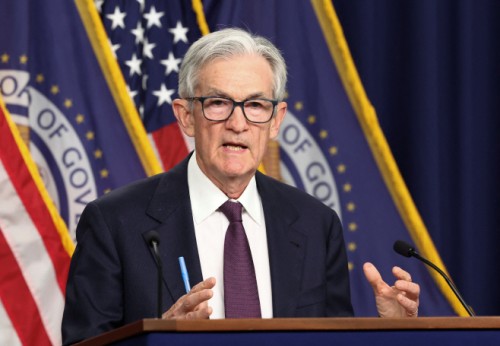 |
| Jerome Powell, Chair of the U.S. Federal Reserve, speaks during a press conference at the Federal Reserve headquarters in Washington, D.C., on May 7. / Source: Reuters, Yonhap News |
The U.S. Federal Reserve decided on May 7 to hold its benchmark interest rate steady at 4.25–4.50%, citing solid economic indicators despite rising uncertainty. The decision came during the third Federal Open Market Committee (FOMC) meeting of the year.
This marks the third consecutive meeting in which the Fed has kept rates unchanged, following three rate cuts totaling 1 percentage point last fall. The decision also came despite continued pressure from President Donald Trump, who has openly urged the Fed to pursue further rate cuts since taking office on January 20.
With the Fed’s decision, the interest rate gap between the U.S. and South Korea (2.75%) remains at 1.75 percentage points at the upper bound.
In its statement, the Fed acknowledged weaker net exports but said that “recent indicators suggest economic activity continues to expand at a solid pace.” It added that unemployment remains low and stable, labor market conditions are strong, and inflation is still somewhat elevated.
At a press conference following the decision, Fed Chair Jerome Powell said uncertainty remains high, admitting, “It is not at all clear what we should do.” He refrained from signaling whether inflation or growth was the bigger concern going forward, emphasizing caution.
Regarding the possibility of a future rate cut, Powell stated, “There’s no need to rush. Patience is appropriate,” but added, “We have a track record, and we’ll act quickly when conditions warrant.”
The Wall Street Journal noted that the likelihood of a rate cut at the Fed’s mid-June meeting has diminished, though investors still widely expect a rate reduction in the second half of the year.
Powell also addressed Trump’s tariff policies, warning, “If the announced steep tariff hikes are sustained, they are likely to increase inflation, slow economic growth, and raise unemployment.”
Despite declining sentiment among markets and consumers in response to the tariff measures, core economic indicators remain firm. According to the Labor Department, the U.S. economy added 177,000 non-farm jobs in April—well above the forecast of 133,000. Consumer spending also rose 1.8% annually in the first quarter, per the Commerce Department.
The unemployment rate held steady at 4.2% in April. However, the economy contracted at an annualized rate of 0.3%, partially due to a 41.3% spike in imports ahead of the tariff hikes.
Most Read
-
1
-
2
-
3
-
4
-
5
-
6
-
7





















